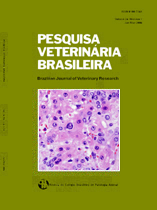 |
|
|
|
Year 2012 - Volume 32, Number 7
|

|
Equine experimental thrombophlebitis: Clinical, ultrasonographic and venographic evaluation, 32(7):595-600
|
ABSTRACT.- Hussni C.A., Barbosa R.G., Borghesan A.C., Rollo H.A., Alves A.L.G., Watanabe M.J., Machado V.M.V. & Cerqueira N.F. 2012. [Equine experimental thrombophlebitis: Clinical, ultrasonographic and venographic evaluation.] Aspectos clínicos, ultra-sonográficos e venográficos da tromboflebite jugular experimental em equinos. Pesquisa Veterinária Brasileira 32(7):595-600. Departamento de Cirurgia e Anestesiologia Veterinária, Faculdade de Medicina Veterinária e Zootecnia, Universidade Estadual Paulista, Rubião Jr s/n, Botucatu, SP 18618970, Brazil. E-mail: cahussni@fmvz.unesp.br
Jugular thrombophlebitis is a common complication of disease processes associated with repeated venipuncture, injection of irritant solutions, and the use of indwelling catheters, especially with bacterial contamination. Bilateral thrombophlebitis may result in edema of the soft tissues of the head, reduction of athletic performance and even death of the animal. This disease, although common in horses, is not much known regarding its evolution and treatment. The aim of this study was to evaluate the clinical and structural changes of experimentally induced jugular thrombophlebitis in horses, through clinical examination, ultrasound and venography of the thrombus and the vessel, verifying the possibility of thrombus recanalization and compensatory produced blood flow. The jugular thrombophlebitis was induced unilaterally into 5 horses, monitored by clinical (general, regional and local) and ultrassonographycs exams. Venographs were made at pre-induction, induction and every 6 days after induction of thrombophlebitis, in order to observe recanalization of the occlusive thrombus and presence of blood vessels in the drainage allowance. Occurrence of moderate edema was observed in the parotid, masseter and supra orbital regions, and mild edema in the submandibular region. The jugular engorgement of the cranial region of induction persisted throughout the period of evaluation. The caudal portion to the thrombophlebitis showed engorgement with compression on the vein at the thorax entrance since the first day after induction. The ultrasound examinations showed total occlusive thrombus formation of 3 animals, partial recirculating flow in the jugular vein in 2 animals, and collateral blood vessels from the cranial obstruction to the caudal portion. The venography revealed normal linear blood flow in the preoperative and occlusive thrombus with contrast directed filling of the vessels to the compensatory portion caudal to the vein occlusion or cranial to the thrombus in the postoperative moments. After vein resection of the segment containing the thrombus, the cephalic edema was less intense than after the induction of the thrombophlebtits. The ultrassonography and venography post resection showed vascularity increase in this region. It was concluded that there is recanalization with endothelialization and vascular compensation made by pre-existing vessels necessary for drainage. |
| |
|
|
| |
|
 |